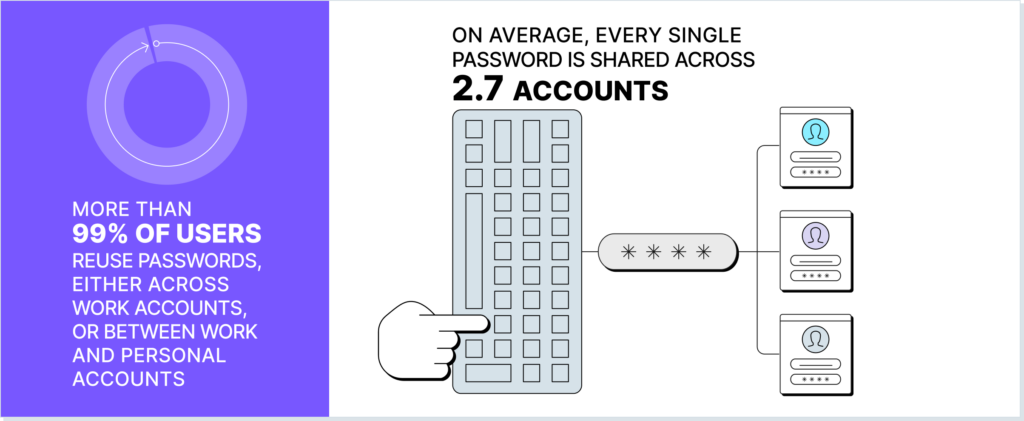Password reuse refers to the insecure practice of using the same password across multiple different accounts, platforms, or services. Password is a risky practice, because if one account with the reused password is compromised, an attacker can use that same password to access and breach all other accounts as well.
For example, if a person uses the same password for their email, online banking, and social media accounts, then an attacker who gains access to their email account, could use that same password to access the person’s banking account and steal their savings. They could also access their social media account to perform social engineering on other users.
In a business setting, password reuse might mean using the same passwords across multiple SaaS applications. Or, reusing the same passwords the user uses for personal activities, in work-related applications. The consequences of password reuse in a business setting could be the disruption or shutting down of critical business systems.
People reuse passwords and reuse credentials because remembering multiple passwords is hard. People need multiple passwords in their day-to-day and they find it easier to remember a single password, especially if the passwords are complex and contain a combination of letters, numbers, and symbols. Password re-use saves time and effort by allowing users to use the same password across different accounts.
In addition, many people are not aware of the risks associated with password reuse. They assume that their password is secure enough and do not realize that reusing passwords puts them at risk of being hacked. Finally, some users may think that their accounts are not important enough to be targeted by hackers. Therefore, they believe that reusing passwords is not a significant risk.
Therefore, it is important to use a unique, complex password for each account. Or, relinquish the use of passwords altogether by using other security solutions.
What are the Risks of Password Reuse?
Password reuse poses several risks to users, including data breaches and compromised accounts and social engineering. The main risks are:
Compromised Accounts
If one account with a reused password is compromised, all other accounts that use the same password become vulnerable to password reuse attacks. Attackers can use the same compromised credentials to access other accounts, steal sensitive information, inject malware, shut down systems, and more.
Identity Theft
If an attacker gains access to a user’s account through password reuse, they can use the stolen information to impersonate the user and commit identity theft. This can lead to financial loss, damage to the user’s reputation, social engineering, the ability to progress laterally in the network, and other severe consequences.
Data Breaches
Reusing passwords makes it easier for cybercriminals to access systems, progress laterally and exfiltrate sensitive and critical information.
Organizational Breaches
If employees reuse passwords between personal and work-related sites and applications, then compromising a personal password could result in a breach to their workplace as well. This puts critical systems and other users at risk.
Mitigating the Risks of Password Re-use
Employers can take several steps to mitigate the risks of password reuse among their employees, like training, policy enforcement and browser security. These include:
Employee Education
Employers can educate their employees on the risks of password reuse and provide guidance on how to create strong, unique passwords and on password hygiene. This can be done through training sessions, online courses, or other means.
Password Policies
Employers can establish password policies that require employees to use strong, unique passwords and prohibit password reuse. These policies can also require regular password changes, rotating passwords, and enforcing password complexity requirements.
Password Manager Tools
Employers can provide employees with password manager tools that generate and store unique and secure passwords for each account. These tools can simplify the process of creating and managing strong passwords and reduce the risk of password reuse. The best part is that employees don’t have to remember the passwords themselves.
MFA
Employers can require employees to use multi-factor authentication (MFA) for added security. This can make it more difficult for attackers to gain access to employee accounts, even if they have stolen login credentials.
Regular Security Audits
Employers can conduct regular security audits to identify potential vulnerabilities in their password policies and take steps to address them. This can help ensure that employees are following best practices for password security and reduce the risk of password reuse.
Browser Security
A browser security platform disables password saving and detect password reuse in non-company sites. In addition it runs password strength checks and manages the sign in process. Employers who implement a browser security extension will reduce password reuse risk.
By implementing these measures, employers can reduce the risk of password reuse among their employees and improve the overall security of their organization’s digital assets.
How can LayerX Protect your Enterprise?
LayerX is a comprehensive browser security solution that offers several features to enhance password protection and prevent password compromise. The solution prevents attackers from accessing passwords stored in the browser by disabling password saving on the user’s profile or local device. It also detects password reuse on non-company sites and can monitor account sharing, to ensure that passwords are not being shared among multiple users.
LayerX also includes password strength monitoring and offers extension password management, which manages the sign-in process for selected applications. This feature provides an extra layer of security and ensures that users are accessing only authorized applications.
Overall, LayerX provides robust password protection features to enhance the security of users’ digital assets and prevent password compromise.
